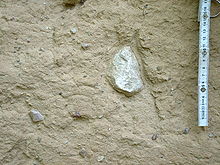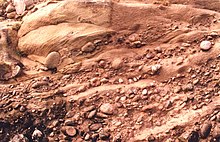Diamictite
Diamictite (Greek δια (diamagnetic) and by μεικτός (meiktós): mixed) is provided as a conglomerate or breccia a little or not sized rock , which in a clayey or silty may contain very different base composition rock fragments. At least 25% of these rock fragments of a diamictite are larger than 2 mm. The rock fragments are angular to rounded and can consist of very different rocks, such as different sedimentary rocks , metamorphic or igneous rocks. The components are mixed by sedimentary processes. Unconsolidated such a sediment is called diamict .
The term was introduced in 1960 by Flint, Sanders and Rodgers as a purely descriptive name for hardly sorted and poorly stratified rocks, which, in contrast to Tillit, does not allow any conclusions to be drawn about a specific origin.
Development processes
Despite the purely descriptive definition, diamictite is often incorrectly equated with the term tillite and is therefore only associated with glacial formation, for example through glaciers , although diamictite can be produced by a number of geological processes.
Formed by glacial processes
Diamictites arise as a direct consequence of the ice movement of glaciers and ice streams by the deposition as glacial tills (Till) in end , side , or ground moraine . Both rock fragments of every grain size , which were transported as rubble on and in the glacier and deposited on the sides or in front of the face of the ice mass, as well as rocks abraded by the ice, especially on its bottom and mixed during transport, contribute to these deposits Underground. The direct melting of debris contained in the ice is less often responsible for the formation of diamictites, as is the deposition of rock debris through mass movements such as ice avalanches that slide off the ice edge and come to rest on land or underwater.
Glacial processes are also related to the melting of rock from drifted icebergs or thawing ice sheets , in which fine particles - as they also occur in glacier milk - and pieces of rock sink after melting to the sea or lake floor and there with those normally deposited there Sediments are mixed and deposited. In the predominantly fine-grained sediment formed in this way, there are often much coarser rock fragments that have deformed the still soft soil layer when impacted from above. Such dropstones can, however, also form through other processes.
Diamictites can ultimately arise from the compaction of soil material when it hits the ground and when icebergs are stranded. Such processes are not limited to extensive icing, they can also be caused by seasonal ice.
Formed by volcanic processes

During the activity of volcanoes , volcanic mud flows ( lahars ) can arise, in which large masses of water pull away volcanic material and other rocks of the subsoil with great force and mix them thoroughly. These mud flows can cover long distances on land and possibly continue as submarine mud flows in lakes or in the ocean. If the transport force of the sludge flow decreases, the mixed sediment solidifies without the various components of different origins separating into layers of different densities due to their static buoyancy .
Formation through relocation processes
Diamictites in a marine environment caused by mass movements such as debris flows (ger .: debris flows ), suspension streams and olistostrome . During these processes, materials of different origins and grain sizes are mixed and deposited unsorted. The mixing of already deposited sediment by submarine landslides also leads to a thorough mixing of different types of material. The formation of diamictites by submarine mass flows such as suspension flows and olisthostromes in tectonically active areas is the most common type of formation of this rock. If the tectonic activity is related to the thrust tectonics of a fold mountain in the process of being formed, the sequences that contain diamictites formed in this way are referred to as flysch .
Furthermore, diamicts can also arise on the mainland through material relocation. Solifluction is particularly effective in the polar regions , causing intensive displacement and mixing processes and thus leading to the formation of well-mixed deposits.
In arid climate of these masses cause sporadic but torrential rains occurring to flush large masses of weathering debris from the mountains and to deposit the mountainous border in the form of alluvial fans (Alluvialfächer). Typical, mostly conglomeratic diamictites, which are also referred to as fanglomerates , arise here as well. If these fanglomerates are the erosion debris of a young, uplifting fold mountain range, they fall under the generic term molasses .
Other geological processes
Diamictites can be created by tectonic processes, in that rock fracture , transport and mixing in fault zones lead in some cases to the formation of a fault breccia in which larger fragments occur in addition to finely ground rock. Depending on the transport distance of the fault and the composition of the rock strata affected, very different rocks can be involved in the formation of the diamictite.
The weathered cover ( regolith ) created by erosive processes can in some configurations lead to the formation of a rock in which rubble from relocation processes and remnants of the original rock of various sizes occur together with finely weathered material.
Diamictites are also rarely formed by processes caused by extraterrestrial sources. When impact of a meteorite the upcoming local rocks are crushed into fragments unterschiedlichster size ejected and deposited unsorted again. An example of such debris is the Bunte Breccia , which was formed when a meteorite hit the Nördlinger Ries around 15 million years ago ( Ries event ). If the rocks involved are transformed by heat and pressure, an impactite is created , which, however, as a metamorphic rock, can no longer be described as diamictite.
Occurrence
Diamiktites occur in all regions of the world, for example in the following geological units:
- as Till or Tillit in all formerly glaciated areas of the earth
- Leather slate in the Thuringian Slate Mountains
- Geschwend-Sengalenkopf unit in the Black Forest
- Colorful breccia in the Nördlinger Ries
- Granville Formation, Brittany
- Fiq formation in Oman
- Chuos and Ghaub formation in Namibia
- Witwatersrand and Dwyka Diamiktites, South Africa
- Rio Ivaí Formation and Itararé Group in the Paraná Basin , Brazil
- Windermere Supergroup in North America
- Elatina formation in Australia
Individual evidence
- ↑ Hall Worth, CR, Knox, RWO'B .: Classification of sediments and sedimentary rocks. British Geological Survey, Research Report RR 99-03, p. 6. (PDF; 470 kB) ( Memento from June 9, 2004 in the Internet Archive ). Retrieved April 12, 2008
- ↑ Flint, RF, Sanders, JE, Rodgers, J .: Diamictite, a substitute term for symmictite. Geol. Soc. At the. Bull. 71, 1809-1810, 1960.
- ↑ a b c d e f Eyles, N .; Januszczak, N. (2004). "'Zipper-rift': A tectonic model for Neoproterozoic glaciations during the breakup of Rodinia after 750 Ma". Earth-Science Reviews 65 (1-2): 1-73. (PDF; 4 MB) ( Memento from November 28, 2007 in the Internet Archive ). Retrieved April 12, 2008
- ↑ a b Huber, H., Koeberl, C., McDonald, I., Reimold, WU: Geochemistry and petrology of Witwatersrand and Dwyka diamictites from South Africa: Search for an extraterrestrial component. Geochimica et Cosmochimica Acta, vol. 65, no. 12, pp. 2007–2016, 2001. (PDF; 470 kB) . Retrieved April 12, 2008
- ↑ Petrography and fauna of the leather slate pebbles (Ordoviz, Thuringia) and their significance for the late Gordovian Ice Age and the paleogeography of Gondwana. Brief description of the DFG project (Ka 917 / 9-1, IGCP 441) ( Memento from October 9, 2008 in the Internet Archive ). Retrieved April 12, 2008
- ^ Ziegler, Peter A.; Wimmenauer, Wolfhard: Possible glaciomarine diamictites in Lower Paleozoic series of the Southern Black Forest (Germany): implications for the Gondwana / Laurussia puzzle , New Yearbook for Geology and Paläontologie: MONTHS 2001, pp. 500–512, 2001 (PDF; 1,686 kB ) . Retrieved April 12, 2008
- ↑ Kilner, B .; Niocaill, CM; Brasier, M .: "Low-latitude glaciation in the Neoproterozoic of Oman". Geology 33 (5): 413-416. doi : 10.1130 / G21227.1 .


